Arkansas’ annual trip to Central Arkansas has been a nightmare over the last several seasons, with the loss to Hofstra last season serving as possibly the lowest point. The Hogs are hoping to avoid a letdown on Saturday against Bradley.
Meet the Braves
Bradley University was founded in 1897. It was originally a training school for watch-makers (horology is the study of watchmaking, if you were curious) that was later expanded into a private university located in Peoria, Illinois.
Bradley has a pretty rich basketball history. The Braves have won four NIT titles – tied with St. John’s for most all-time – and reached the national title game in 1950 and 1954 under legendary coach Forddy Anderson. Their 1950 Final Four team was embroiled in one of college basketball’s most famous scandals: the City College of New York point-shaving scandal. Multiple players for Bradley, CCNY (who beat Bradley in the national title game), and several other universities were paid bribes to help fix the scores of games for bettors. The scandal also included Kentucky (of course), who was the only school to escape without major sanctions (of course).
In more recent years, the Braves are coached by Brian Wardle, who is in his eighth season. After a 5-27 debut season, Wardle has mostly had the Braves above .500 in the difficult Missouri Valley Conference, though his teams have never finished better than third.

Bradley’s last game against SIU Edwardsville ended in controversy, as SIUE’s buzzer-beater apparently didn’t quite beat the buzzer. I say apparently, because the cameraman wasn’t paying attention and missed the play of the game:
The Braves have a tremendous defense, and holding opponents in the 40s and 50s is normal. However, they gave up 80+ to their two strongest opponents, Auburn and Utah State. We’ll look at why in a bit.

Model pick: Arkansas 70, Bradley 60. The model normally applies a 4-point swing to home teams, but I made it 2 points for this one, as this is not a true home game, even if it’s not neutral.
When Bradley has the ball

Bradley’s offense is not good. Let’s start with that. Fortunately for them, they are aware of this fact, so they make an effort to get in transition and score before the opposing defense gets set up. That’s where this game has some letdown potential. If the Hogs are unfocused following the big win over Oklahoma, it will show up in the transition defense. That’s what Bradley is going to try to punish.

Bradley plays fast because that’s their best bet to create open 3-pointers. As we’ll see below, all four of the guards in their regular rotation will take more than half their shots from beyond the arc. They don’t get to the rim well and they don’t draw fouls, because they just want to shoot jumpers. They will happily live and die by the 3-pointer. When forced into halfcourt, they make a more concerted effort to get the ball inside, but in the fast-paced game that Arkansas wants to force, they are likely to bomb 3-pointers and hope for the best.

The Braves have a very international roster, drawing players from Canada and Europe. They have a lot of size for a mid-major team, and their frontcourt is pretty scary, especially on defense.
Up front, they start with veteran center Rienk Mast, a 6’9 Dutch-born member of the MVC all-defense team. Mast is an excellent defensive rebounder and occasional shot-blocker. Offensively, he’s surprisingly strong on the perimeter, working in pick-and-roll situations where he possesses a nice little floater. He can hit from beyond the arc if left open. His main weaknesses are turnovers (25%) and poor finishing at the rim. Mast missed Bradley’s first six games as he recovered from an offseason knee surgery, but since his return, he leads the Braves with 26% usage, so expect him to get a steady volume of shots.
Bradley’s two other forwards are elite defenders. First up is 6’9 Dutch-born stretch-4 Malevy Leons, who grades as the Braves’ best player (+8.4 aBPM, 96 grade). Offensively, Leons is a pure perimeter player who takes almost half his shots from beyond the arc, where he shoots an excellent 39%. He can occasionally track down offensive rebounds as well, and he doesn’t turn it over much. Those things have helped him lead all Bradley starters in offensive rating (115.8) and net offensive points produced (+3.3). But offense isn’t even his strength. Defensively, he’s an elite help defender, using his long arms to lead the Braves in both blocks and steals per game. Joining him in the frontcourt is 6’9 Darius Hannah, an aggressive defensive specialist. Hannah ranks second on the team in net defensive points produced (+2.2). He’s also second behind Leons in blocks and third in steals. Offensively, he’s very low-usage, though he is the only Bradley player to take more than half his shots at the rim, where he’s a decent threat for quick putbacks. Fouls are a major issue for him, as he fouled out of the Utah State and Liberty losses and had four fouls against Auburn.
As good as the frontcourt is, the backcourt has struggled. Bradley has handed the keys to the offense over to 5’8 Duke Deen, a transfer from Troy. On defense, Deen is second on the team in steals – helping him rank third in net defensive points produced – but his point guard work on offense leaves much to be desired. He’s an okay distributor, but he shoots too often for a guy hitting just 31% from beyond the arc. His turnover rate of 21% is also a bit high, and that was a problem for him at Troy too. The shooting guard is 6’3 Connor Hickman, who grades as Bradley’s worst starter. His 3-point shot goes in at a decent rate, but he doesn’t do much else well, including shooting inside the arc. Like Deen, he also turns it over too often, but unlike Deen, he’s a bit of a defensive liability, recording easily the worst net defensive points produced (+0.2) of all Bradley starters.
Off the bench, the main name to watch is 6’4 Finnish-born shooting guard Ville Tahvanainen. He’s another 3-point threat (35%) who will take about half his shots from beyond the arc. He’s less turnover-prone than Hickman or Deen, but he’s also not a great defender. The emerging guy is 6’7 wing Christian Davis, a very-low-usage 3-point sniper who offers good defensive length. Finally, there’s 6’6 wing Zek Montgomery, who has missed most of the season with an injury but appears to be back healthy. Montgomery is an above-average defender who, unlike all of his teammates, appears to be pretty good at getting to the line as well. Montgomery’s return and Davis’s rise have eaten into the minutes of 6’0 guard James Weathers, Bradley’s lone dribble-drive threat who is struggling on offense but solid on defense.
Scheme
Bradley runs a 4-out scheme that is very heavy on ball screens. They like to use their bigs to set screens for the guards, knowing that defenses don’t like having their own bigs wander out to the perimeter. If the defender plays “drop” coverage (stays back) on the switch, the Braves will happily launch an off-the-dribble 3-pointer:
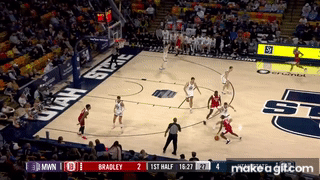
Note that this shot occurred just five seconds into the possession.
Modern basketball analytics hates off-the-dribble 3-pointers – aka “pull-up” 3s – as they are usually made at a lower rate than their more efficient cousins: catch-and-shoot 3-pointers, aka “spot-up” 3s. Steph Curry and Damian Lillard are among the NBA guys who have made the pull-up 3 work, but I don’t see any Stephs or Dames on this Bradley team.
However, pull-up 3s are a great way to take advantage of openings against man-to-man. Here’s another one, a handoff to Hickman from zoom motion leading to a pull-up 3:
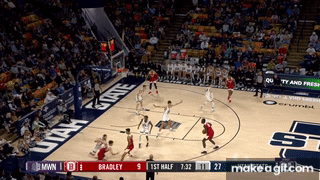
While that shot is difficult to defend, the defense can take solace in the fact that those shots usually don’t go in at a high rate. The danger is that they are hard to stop if they get hot off of these.
Of course, Bradley will take spot-up 3-pointers too. This is a clever pick-and-pop for Hickman with a second ball screen to free him:
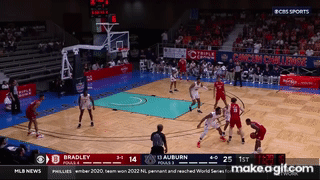
Bradley can attack different types of defenses to create 3-point shots. Against Utah State’s pack line, they wanted to punish the one-pass-away defenders who play in the gaps. Here, the guard sees drop coverage and knows he can use the ball screen to directly attack the one-pass-away defender, who is responsible for both his own man and stopping the ballhandler’s dribble drive. But he’s not athletic enough to cover both:
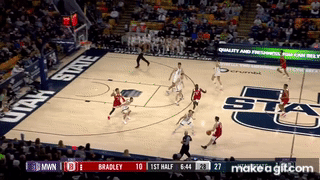
Now we come to Bradley’s problem: where’s the follow-up? If Utah State had called the Braves’ bluff and stayed with the shooter there instead of helping stop the drive, could that guard have taken it to the rack? The answer is a resounding “no”. Bradley’s perimeter players are pure jump-shooters.
See for yourself:

Bradley’s four main guards have combined for 58 shots at the rim this season: that’s less than six attempts per game, despite Deen and Hickman leading the team in total field goal attempts. Even the forwards (outside of Hannah) won’t spend much time near the rim.
The key for Arkansas here is pretty obvious: stay in front of shooters. Bradley will try everything in the book to create open 3-point looks, and they are not afraid to pull up off the dribble if you give them space. Everything else, the Hogs can pretty easily contain. Mast may get some shots, but Arkansas has the athleticism to avoid major damage from his unique skillset.
When Arkansas has the ball

While the Braves’ offense is focused on just trying to get hot, the defense has been the bread-and-butter under Wardle. Last year’s team finished 50th in adjusted defensive efficiency, but so far this year, this team is even better.
Bradley’s defense has some things in common with Oklahoma’s: both are primarily man-to-man, and both try to limit transition and force long halfcourt possessions instead. But the similarities end there. While Oklahoma philosophically wants to smother the perimeter and force tough two-point shots, the Braves want to force jump shots. They are happy to allow midrange jumpers and semi-contested 3-point shots if they can keep you away from high-percentage shots at the rim. On paper, that’s a tough matchup for the Hogs, who are excellent at the rim, but very bad at jump shooting.

The Hogs now sit at 1st in the nation in field goal percentage on layups, dunks, and tip-ins after shooting 84% against Oklahoma’s solid rim defense. But Bradley is a unique challenge. The Sooners allowed the Hogs to get inside the arc and tried to contest shots at the rim, and it didn’t work. But Bradley doesn’t want you to even get a shot at the rim.
So how do they prevent shots at the rim? The scheme has some pack line elements to it, so that’s part of it. As part of the pack line, the Braves typically position their one-pass-away defenders in the gaps so they can give early help to cut off paths to the basket. They are best when defending ball screens, often employing a “hard hedge”, where the screener’s man aggressively cuts off the ballhandler and forces him to retreat:
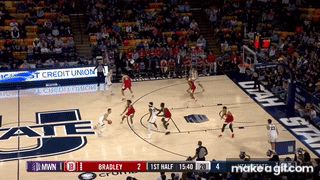
Note the backside defender sliding down to the post to act as help in case of a pick-and-roll. He leaves a shooter open on the opposite side, but the Braves are gambling that the hard hedge makes it impossible for the ballhandler to make that crosscourt pass.
That help defense inside the arc aims to take away a path to the basket and allow the defense to collapse on the ball once it comes inside the arc. That’s where Bradley’s three-forward defense becomes a problem, as all three of those guys are shot-blockers. Most of Bradley’s blocked shots come from the help defender, not the on-ball defender. Smaller teams don’t even try to go inside against those trees, hence the excellent rim share ranking.
Against stronger opponents (like Auburn), the Braves tried fronting the post. I have not seen many teams front the post this often and this aggressively. They don’t even want the ball caught on the elbow here:
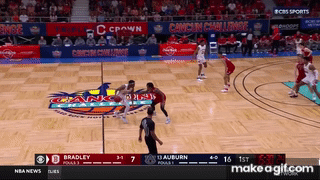
And the Braves definitely didn’t want Auburn star Johni Broome getting a paint touch:

This aggressive post-fronting allows the Braves to avoid traditional post-ups and instead force opponents to get past their help defense, where they have a better chance of blocking shots. Auburn was able to throw it over the head of fronting defender a few times, however.
While Bradley’s aggressive and long defense has dominated weaker competition, the Braves gave up more than 80 points to both Auburn and Utah State, the only two offenses with a pulse they’ve faced. How’d that happen? The short answer is that Bradley’s team size sacrifices athleticism, so teams that are significantly more athletic, but not significantly smaller, have a major advantage. That would be Arkansas.
That manifested itself in the foul situation. Both Auburn and Utah State shot a lot of free throws. We saw what happened when a less-athletic player tries to play man defense against a very athletic opponent when Oklahoma’s Tanner Groves fouled out on Saturday. Groves collected blocking and grabbing fouls because he routinely got in defensive position just a hair too late. That’s going to be Bradley’s problem.
Both teams exposed Bradley’s lack of athleticism by spacing them out and putting help defenders in conflict between helping and staying with their own man. Lack of athleticism often shows up in recovery and closeouts, and Tahvanainen, who’s trying to help in the post, gets a terrible closeout on his man:
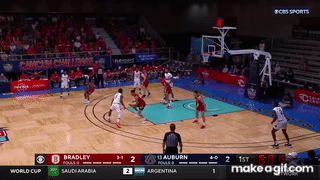
The excellent spacing of the Tigers makes this play possible. Auburn had several plays like this early, letting the Braves know they were in over their head. But once the help defense got scared to stray too far from shooters, then Bradley’s on-ball defenders were stuck in one-on-one situations with Auburn’s guards.
Watch Deen (#21) want to help on this iso but also know that he can’t leave his own man:
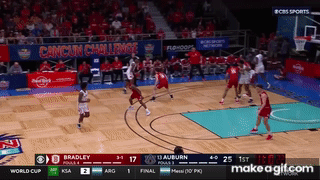
When you aren’t athletic enough, even playing aggressively can backfire. Here, Bradley tries to hard hedge a slip screen, but the defenders don’t really pincer the ball, leaving an easy path to the basket:
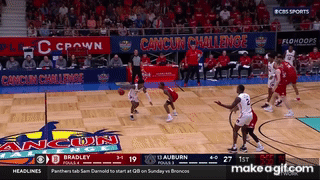
What kind of gameplan will we see from the Hogs? Some of what the Hogs did to Oklahoma will still work. As expected, the Hogs went a bit isolation-heavy against the Sooners, counting on their bigger and more athletic guards to be able to drive. That might still work against Bradley, whose guards are even smaller and even less athletic. But the Braves are much more willing than the Sooners to give early help out on the perimeter, so if they get desperate, they will certainly be more willing to force Arkansas to win with jump shots. If they do get aggressive – and the Hogs are properly-spaced – open 3-pointers should be available.
The other option if the Braves go all-in on early help is the pick-and-roll game, which is a specialty of Anthony Black and Nick Smith. Bradley’s hard hedges are dangerous against weaker opponents, but Arkansas’ tall guards might be able to break them down by simply throwing over the hedge or, if Bradley cannot close quickly, just dribbling between the defenders.
Keys to the Game
- Create some foul trouble. Bradley’s aggressive defense means their thin frontcourt collects fouls at a high rate, while the bench is full of smaller players. Forcing any of Bradley’s three 6’9 starters to the bench will open up more chances to get to the basket.
- Maintain good spacing. This is always important, but taking advantage of an athletic advantage requires excellent spacing. The Hogs didn’t have it against UNCG, but they did against Oklahoma. Against a defense willing to give help, off-ball players have to be intentional with their movements on the floor.
- Get back on defense. Bradley will have a hard time getting to the rim or looking particularly good in halfcourt, but they can punish a lazy defense in transition. The Hogs have to take away the early offense, particularly the 3-point shot. The Braves will have a difficult time creating open 3-point looks when forced into halfcourt sets.
Thanks for reading! Be sure to follow us on Twitter.
The latest from Fayette Villains, straight to your inbox
Enter your email to subscribe and receive new post alerts and other updates. You can unsubscribe at any time.